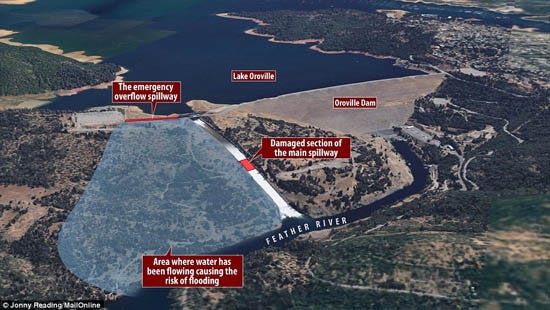Oroville Dam threat grows as does blame
Authorities in California were so sure the Oroville Dam was going to catastrophically collapse that they abandoned their command post on Sunday evening with Acting Chief of the Department of Water Resources Billy Croyle ordering his staff to flee.
Officials also admitted they are in a race against time to drain up to 50-feet of water from the stricken Dam before a storm hits Wednesday. Almost 200,000 people were frantically ordered to evacuate along a 40-mile stretch of the Feather River below the dam.
No sooner had officials issued an emergency evacuation order than the political arguments began. Was it the federal government’s fault for not being attentive enough? Or was state government to blame for rejecting proposals to raise the dam and spending money on high-speed rail instead?
The San Jose Mercury News has an answer: both are to blame, for ignoring a warning raised in 2005 that the emergency spillway could fail in heavy rain the paper reported Monday.
According to the report, three environmental groups — the Friends of the River, the Sierra Club and the South Yuba Citizens League — filed a motion with the federal government on Oct. 17, 2005, as part of Oroville Dam’s relicensing process, urging federal officials to require that the dam’s emergency spillway be armored with concrete, rather than remain as an earthen hillside.
FERC rejected that request, however, after the state Department of Water Resources, and the water agencies that would likely pay the bill for the upgrades, said they were unnecessary.
One of the best event summaries of the current crisis may be found on The Daily Mail (as usual, foreign press reports more detail than American media) which sound a clear alarm that the second storm set to hit the tallest dam in America could cause devastating 100ft deep flood that will leave 200,000 homeless and several towns 100 foot underwater. All 23,000 soldiers of the California National Guard are on standby for both rescue and recovery.
The main spillway has a 250-foot wide and 40-foot deep chasm that has affected drainage. The emergency spillway is a wooded embankment and was used for the first time in history on Saturday.




